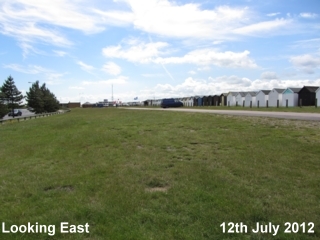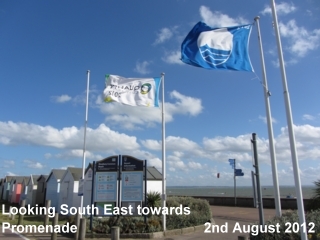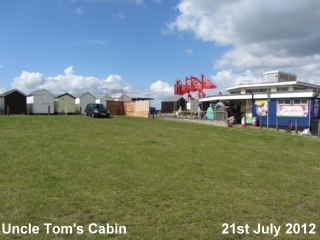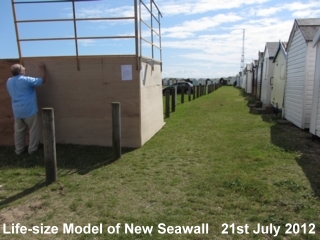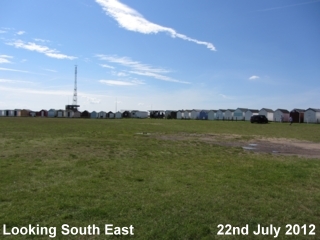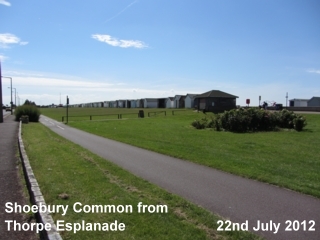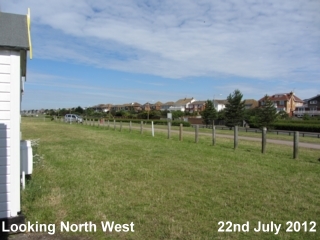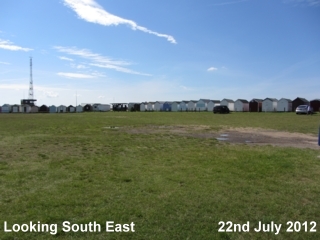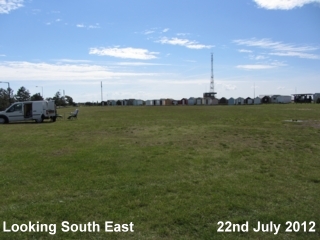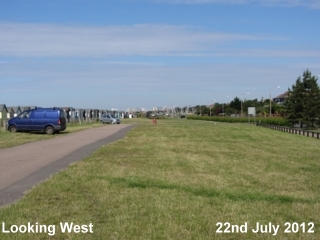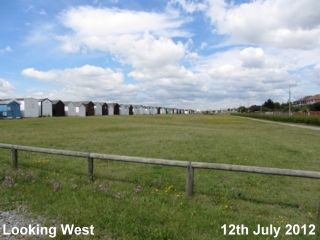

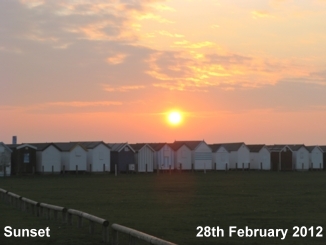
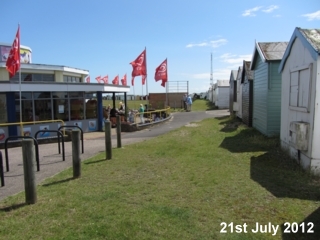
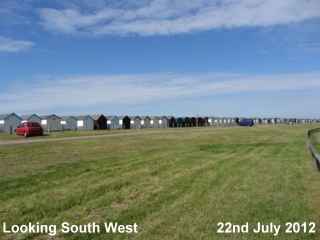

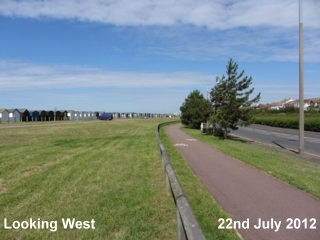

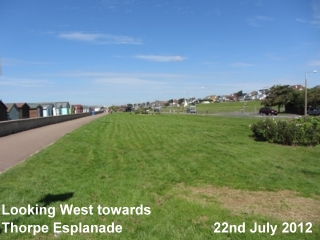

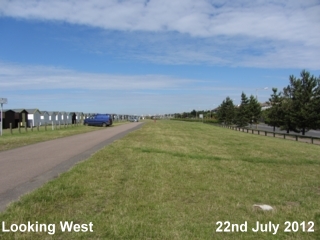
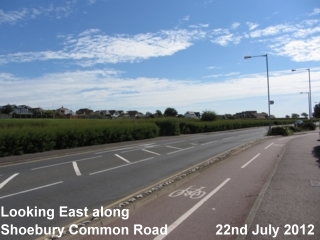
Is the Peace, Tranquillity and Beauty of Shoebury Common under Threat from the Council's Proposals? |
Objections to the Council's preferred option to set the wall behind the huts on Shoebury Common can be summarised as follows:1. SecurityThe proposal will have a potentially negative impact on security. The area between the backs of the huts that stand on the Common and the new seawall will undoubtedly become a high-risk area, a “muggers’ paradise”. This area will be largely obscured; there will be plenty of hiding places. At present, Shoebury Common Promenade has a fairly open aspect from all sides. It is quite safe for young families and people to come on their own, even in the late evening. A simple pleasure that can be rarely enjoyed these days! The open aspect of the area gives security. There are no hidden corners, activities can be easily seen. Should someone feel their personal safety is threatened, it is quite easy to slip between the huts, on to the Common where you can readily be seen from the road and find help. The new seawall will make this impossible, activities on the Promenade will not be visible from the road and this will undoubtedly increase the potential for bad behaviour, vandalism and assault. Safety and security are valuable aspects of Shoebury Common, vital for each individual as well as for that of the whole neighbourhood. If the new seawall is positioned behind the huts as is proposed, the relative security of this pleasant environment will be lost forever. The Council is proposing introducing security lighting and even CCTV cameras to reduce anti-social behaviour. Lighting will not help; it will just assist the perpetrators of such crimes by illuminating the targets of their activity, no need to bring their own torches. It will not make vandals and muggers visible from the road nor from the houses behind. Motion sensor lights would be triggered by every wandering fox, rabbit or rodent and so before long ignored by anyone suspecting criminal activity. Similarly CCTV cameras would only act as a small degree of deterrent. They would need to be continuously manned to alert police and security. The cost of employing someone to watch the monitors would be expensive and instant response would still be out of the question. I might add that the mere presence of such security measures would greatly reduce the attractiveness of this area. For many years, beach hut owners have been refused planning permission to include roller shutters in the design of their beach huts. The Council Planning Department has said that such measures would give the impression that the area was of a high security risk. How much more of a bad impression would security lighting and CCTV cameras give! I am quite sure people would choose to stay away if they thought their relaxing on the beach was being observed and recorded. “Big Brother is watching you” indeed! 2. Change in Character and Nature of the AreaShoebury Common was given at the beginning of the 20th Century to Shoeburyness Urban District Council on the understanding it would be maintained: "as an open space for the recreation and benefit of the inhabitants of South Shoebury and others". This responsibility was passed on to Southend Borough Council when Shoeburyness was absorbed into Southend on Sea in the 1930s. The way of life here has changed little since those early days. Shoebury Common is a very special and unique place to us and all who visit it. It is largely unspoilt, has been enjoyed by people over the years and has a charm and character of its own. There is an easy, relaxed, secure atmosphere. Visitors still flock in their thousands, as the recent warm spell proved when it was hard to find a parking space in the car park. Some travel great distances, more are coming from abroad. Generations have come to enjoy the Common and the Beach. Children play where their forefathers have played. Whether it is swimming, mudlarks, impromptu games of cricket on the Common, rounders or kite-flying, it is an important recreation area, vital for personal well-being. A happy, social atmosphere pervades, all are welcome to enjoy themselves and relax from the pressures of modern living. It is good that the town can present to visitors such a pleasant and popular place. It is very sad to see how the proposed changes with its system of walls and floodgates will spoil the place. A system of walls topped with railings and ugly floodgates with security lighting and CCTV cameras will dramatically alter the whole pleasing appearance to give the impression more of a prison camp than a seaside resort. It will no longer be the: "open space for the recreation and benefit of the inhabitants of South Shoebury and others". Blue Flag AwardThe beach has for several years gained a Blue Flag Award by meeting stringent standards for water quality, safety, facilities, access, environmental education and information. This is a great attraction to visitors. It is now, as of 16th August 2012, the only beach in the Southend area that reaches the Blue Flag standard
Local Wildlife SitesThe importance of the area for nature conservation has been recognised as both North and South Shoebury Common are designated Local Wildlife Sites. As such I understand they are afforded protection through the local planning system. 4. Disabled accessShoebury Common is a popular place for the disabled to visit. Elderly people stroll along the promenade, many pushing their disabled relatives in wheelchairs. At present, there is easy access. The proposal does include the provision of ramps for disabled access. However, considering the height of the new wall, I fear many disabled and less-fit would not have the strength or ability to use these steps and ramps. Not all disabled come here by car. Many come from nearby houses in motorised wheelchairs. If access to the promenade involved using a ramp, this would be an added hurdle that might make visiting impossible. Shoebury Common must not become closed to many of the very people it was given to. Some have been enjoying it all their lives and would like to see future generations deriving the same pleasure from it. 5. The FloodplainThe area behind the beach huts is an important floodplain. The ground level falls away to the road creating a natural basin. The soil is sandy providing good drainage. Together, these factors act as a safely valve to absorb much of any floodwater. This was demonstrated in the 1953 floods when floodwater was largely contained in the basin of the floodplain. Eye witnesses say the sea flowed across the Common and swept beach huts to the back of the Common. It carried on into the area now known as Gunners' Park and up as far as Campfield Road. Because of the floodplain, property in the area was saved from flooding, as is recorded by the Essex Record Office in a book, written by Hilda Grieve, one of its two senior archivists at that time. The book was published by Essex County Council in 1959 and is entitled, “The Great Tide”. It gives in-depth detail of the 1953 floods in Essex. On page 359, one reads: “Fortunately, in the Ness Road area, where another pumping station was out of action, there were no houses affected.” The water that did not drain away naturally was pumped away, (p718). Effective Floodplain ManagementIn accordance with Environment Agency policy, it is important that, “effective floodplain management is in place”. The existing soil on Shoebury Common is River Terrace Deposits, largely sandy, permeable enabling floodwater to soak through. The soil proposing to be deposited on top to form the new embankment is of “stiff London Clay and mixed sands and gravels”. London Clay is impermeable and water will not soak through easily. This will have the effect of destroying the natural drainage benefits of the floodplain as it is today. 6. Pluvial (Rainwater) FloodingWhen flooding hit Shoebury on 15th September 1968, it was caused by excessive rain which led "The Shoe" to overflow. I recall that from Campfield Road round to Waterford Road, Ness Road was under water. Houses in Ness Road were flooded. However, the water was able to flow freely down to the floodplain of Shoebury Common, preventing worse damage. Admiral’s Estate has been built since the flooding of 1968. Many of the houses back on to Ness Road. Could this flood water be held back by the embankment of soil that the Council proposes to dump on Shoebury Common? Could the flood water be trapped on the landward side and damage houses in its path? From Gunners' Park, The Shoe continues down to the sea by way of a man-made “lock”. If the tide is high, water would not be able to progress to the sea, it would be held back by the tide.
|
